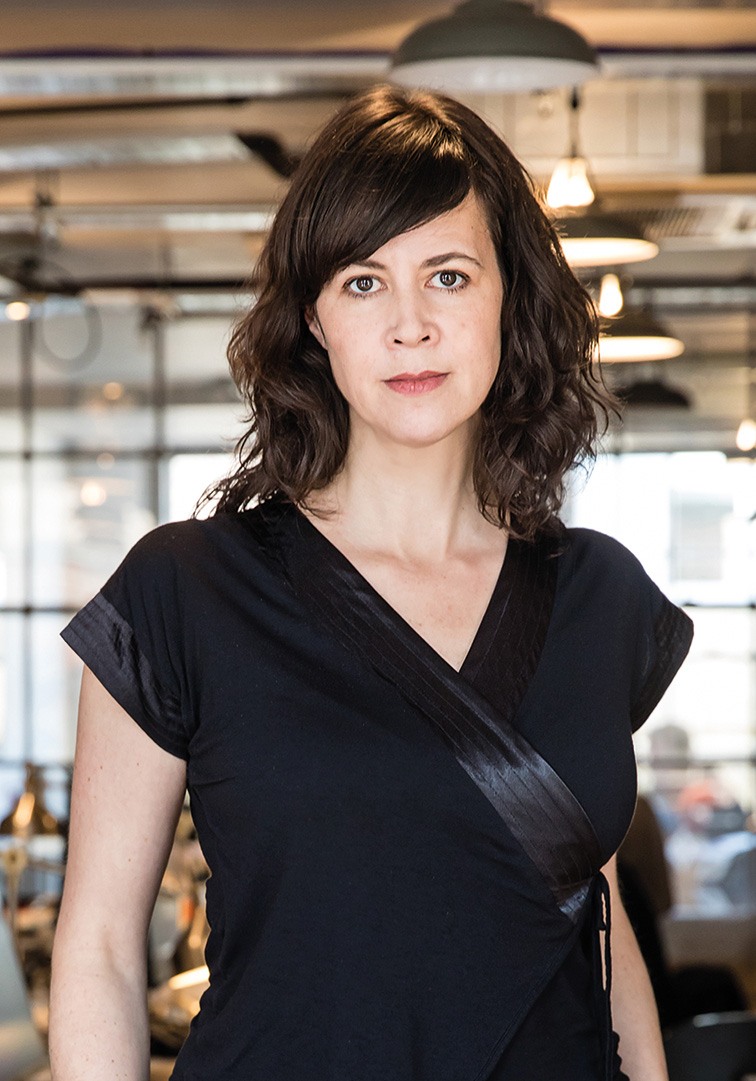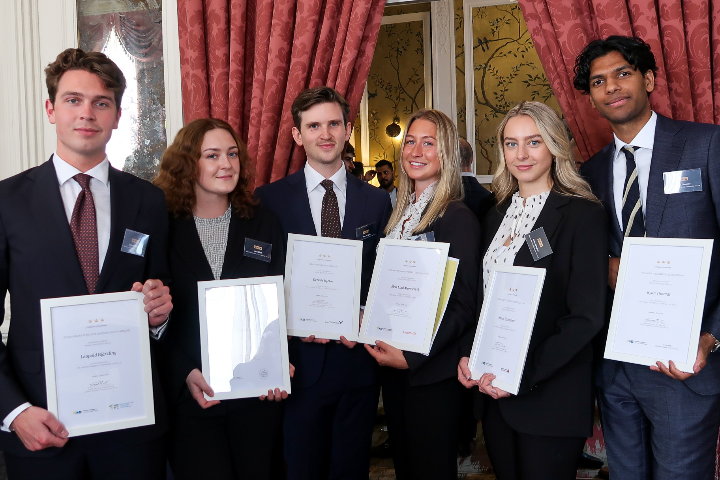
MEET Linda Thiel, Director at London Studio of White Arkitekter
07 May 2020
Founded in 1951 in Gothenburg by Sidney White, almost 70 years later, SCC member White Arkitekter has grown into a collective of nearly 800 architects. The Link met with Linda Thiel, Director at the London Studio of White Arkitekter, to discover the legacy of the architecture firm and its dedication to sustainability and innovation.
Originally from Stockholm, Linda Thiel studied architecture at the Royal Institute of Technology. However, Linda did not anticipate becoming an architect as a child – instead she aspired to work in the music industry. Having been inspired by a friend’s parents who were both architects, she applied to architecture school. “I have no designers or architects in my family, so I think everyone was surprised when I applied to architecture school and got accepted. I haven’t regretted it for a second,” says Linda.
After her studies she set up a small architecture practice with her husband, Lukas Thiel. In 2007 however, she decided it was time to take on larger projects and consequently joined White Arkitekter. In 2015, Linda was once again ready to do something different, wherefore she moved to London to help White Arkitekter set up an office in the city. For Linda, moving to London was an easy choice: “Since both Lukas and I are architects, we had always said that with our profession we could work anywhere in the world. London was an easy step – I have relatives here and we were ready to do something different.”
Linda enjoys working for White Arkitekter for a multitude of reasons. The best part of her job is meeting so many people – from the client teams, to the end-users and the engineers. She also enjoys the fact that she creates designs with an impact. “I love that I am able to bring forward good designs that make a difference, designing solutions to some key challenges in our communities – be it housing, schools, workplaces or hospitals”. Furthermore, Linda appreciates the dynamic aspect of the business: “It is great to be part of a big, creative multidisciplinary collective, with a long heritage of working alongside society, pushing boundaries and working with innovation in the built environment.” She also likes the fact that the company is employee owned. “Because of its ownership model, there is a strong commitment among the employees, and we have managed some significant transitions over time. From the start there has been an interdisciplinary approach and close relationship to academia and research.”
A Swedish heritage
Influenced by its Swedish heritage norms throughout time, White Arkitekter has an open organisational structure. “With our expansion in Sweden during the 50s and 60s, when the welfare state and the Swedish model was developed, the practice grew alongside society. We have a clear bottom up structure with a strong local presence that embraces diversity,” says Linda. Moreover, she believes that the simplicity that the practice uses in its brand and approach is rooted in the Swedish and Scandinavian heritage. “Our brand and approach are certainly rooted in the Scandinavian design tradition. I used to explain that the core of Scandinavian design is the ability to make a lot out of almost nothing. Having been a rural country historically, we have had to create spaces with little means and focus on the quality of light and materials.” What truly sets White Arkitekter apart in the industry however, is its strong dedication of collaborating with its clients, according to Linda. ”Our desire to collaborate – to work with our clients, not just for them – to develop common knowledge and achieve a shared vision, sets us apart in the industry.”
Establishing in the UK – a learning experience
In 2015, White Arkitekter decided to establish an office in the United Kingdom. Yet they already started exploring the United Kingdom market back in 2008. “My colleagues developed good relationships here. We then focused on competitions, made friends with collaborating partners and strategically targeted a few sectors for some years. Eventually in 2015 we decided that the time was right to open a studio, having had some success in competitions.” Over the course of time, the London Studio has increased its workforce from employing three to 17 architects.
The expansion to the UK market meant working in a different manner than in Sweden, which has been a learning experience according to Linda. “It is more common in the UK, for example, to work as Lead Architect managing the design team. The workload and speed of projects is noticeably different too. The pace at which projects are planned and progress here is much faster.” However, the journey has not only resulted in learning experiences for the London office, but for her colleagues in Sweden as well. Linda explains that Swedish architects have experience designing with off-site and modular construction methods, whereas the British architects have more knowledge of traditional constructions. On top of this, the workforce at the UK office is quite diverse which gives them even broader perspectives. As a result, the two branches have been able to exchange their expertise.
Sustainability at the core of business
Over the last ten years consumer demands and expectations have dramatically changed. One thing that has impacted customer behaviours is the increasingly urgent climate crisis. “Climate emergency awareness is much more present now not only from an energy point of view, but also with regard to social aspects, diversity and inclusiveness. This is something we have been concerned with at White Arkitekter over the last couple of decades, which has led us to employ social anthropologists. Nowadays these conversations are not so unusual,” says Linda.
With a mission to “enable sustainable life through the art of architecture” and a vision to only make carbon neutral architecture by 2030, White Arkitekter is at the forefront of sustainability. But how do they obtain these ambitious goals? Linda believes it is important to “walk the talk” which is something that White Arkitekter has succeeded with through a wide range of internal and external initiatives. For example the project “Place for Girls” supports gender equality and diversity in the industry, whereas the company has cut its CO2 emissions per employee by 66% over the last 5 years.
White Arkitekter contributes to obtaining the UN Sustainable Development Goals, by promoting participatory planning in order to develop fair and healthy cities. Their main focus lays on ensuring wellbeing, equality and sustainable cities. In addition, there are more environmentally focused goals such as reducing energy consumption, mitigating climate change and promoting biodiversity. “To ensure that we obtain these goals, we annually evaluate our delivery performance on the goals through our projects. In 2019 we concluded that 55% of all our projects had well-defined climate goals, for instance,” says Linda.
A company structure that lets innovation thrive
Innovation is important for White Arkitekter. The firm has implemented a “bottom-up” structure, which is essential for the development of the company. This is something that is well tied to the company culture. ”We strongly believe in encouraging everyone to be curious and therefore invest in many ideas to implement a culture of innovation,” says Linda.
White Arkitekter has for a long time understood the importance of technology in order to develop further. “In relation to digital technology, we have pushed for Building Information Modelling in order to construct more efficient buildings, for over 15 years and Computational Design Development in regard to analysis, design and fabrication for 10 years,” Linda explains. Nowadays this knowledge is used to enforce sustainable activities: “Current efforts include applying these competences to life cycle perspectives, reusing material, additive manufacturing such as 3D printing and generative design approaches in order to find the optimal design, at all scales. This is made possible through in-house competence, continuous development and our research and development focus.” She also mentions ‘Informed design’ as an example of how technology drives sustainability. “Informed design relates to how we will use digitalisation to achieve a design in line with the UN Sustainable Development Goals and explore new tools where we connect to end-users as well as construction sites. This will have a huge impact at different scales, from how to reuse materials, to the transformation of communities,” Linda says.
Many projects in the pipeline
But what is in store for White Arkitekter? According to Linda there are many projects in the pipeline in the United Kingdom and Sweden. In the UK the firm is currently working on several large housing projects in East London and has recently been shortlisted for two new masterplan competitions. The office in Sweden has been at the forefront as well. “In Sweden we have just completed several new award-winning hospitals, such as Danderyd and Huddinge. Our new student support hub in Linköping, ‘Studenthus Valla’, just won the Building of the Year Award. In Skellefteå our “Sara Culture House” is rapidly moving towards completion – this 18-storey timber building is getting a lot of credit across the world,” Linda explains.
An industry in constant change
Linda believes that the architecture industry will continue to change, adapt and develop over time, both in the short and the long haul. “In the immediate future, we anticipate changes in light of the COVID-19 pandemic. This will have an impact on urbanisation and the built environment on many different levels. These considerations affect everything from how we socialise and relate to urban spaces, to the practicalities of delivering projects. For instance, many construction sites have had to close, meaning there will be a delay in the delivery of much needed homes, schools and health facilities.” Furthermore, she appoints the mitigation of climate change as a major challenge ahead: “On a broader outlook, the climate emergency will bring forward a change in our industry – we will move towards a more circular economy and re-use of existing buildings and places.” The density of cities and designing for inclusivity are also topics that are high up on the agenda: “We need to continue to share knowledge and not create barriers. We need to build more partnerships to manage the challenges ahead,” Linda concludes.
East London Gascoigne estate housing project. Photo: White Arkitekter.
BY: HEDVIG ASTBERG
.jpg)
.jpg)

